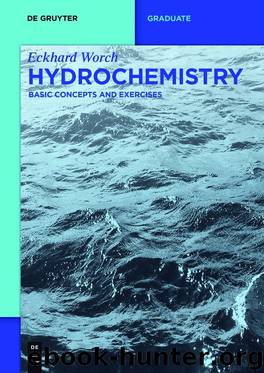Hydrochemistry: Basic Concepts and Exercises by Worch Eckhard

Author:Worch, Eckhard [Worch, Eckhard]
Language: eng
Format: epub
Publisher: De Gruyter
Published: 2015-05-07T16:00:00+00:00
With γ1, we can calculate the activity coefficient of the Tillmans equation:
Now, we can insert all data into the Tillmans equation to find c(CO2):
A graphical representation of the Tillmans equation is shown in Figure 9.1. The curve represents the equilibrium states, here calculated for the condition 2c(Ca2+) = 0 and under the simplifying assumption fT = 1. In the area above the curve, we find all water compositions (with respect to CO2 and ) where the CO2 concentration is higher than in the state of equilibrium. Such waters can reach the equilibrium state by dissolving calcium carbonate (calcite) as can be seen from Equation (9.4) (reaction from left to right). They are therefore referred to as carbonate-dissolving or calcite-dissolving waters. Waters with compositions that fall into the area below the equilibrium curve contain lower CO2 concentrations in comparison to the equilibrium. They can reach the equilibrium state by precipitating calcium carbonate (Equation (9.4), reaction from right to left). Such waters are referred to as carbonate-precipitating or calcite-precipitating waters.
The lines in the sketch represent water compositions with equal pH. The respective linear equations can be derived from Equation (9.8):
Download
This site does not store any files on its server. We only index and link to content provided by other sites. Please contact the content providers to delete copyright contents if any and email us, we'll remove relevant links or contents immediately.
| Automotive | Engineering |
| Transportation |
Whiskies Galore by Ian Buxton(41537)
Introduction to Aircraft Design (Cambridge Aerospace Series) by John P. Fielding(32893)
Small Unmanned Fixed-wing Aircraft Design by Andrew J. Keane Andras Sobester James P. Scanlan & András Sóbester & James P. Scanlan(32579)
Craft Beer for the Homebrewer by Michael Agnew(17938)
Turbulence by E. J. Noyes(7708)
The Complete Stick Figure Physics Tutorials by Allen Sarah(7148)
Kaplan MCAT General Chemistry Review by Kaplan(6603)
The Thirst by Nesbo Jo(6444)
Bad Blood by John Carreyrou(6283)
Modelling of Convective Heat and Mass Transfer in Rotating Flows by Igor V. Shevchuk(6230)
Learning SQL by Alan Beaulieu(6041)
Weapons of Math Destruction by Cathy O'Neil(5842)
Man-made Catastrophes and Risk Information Concealment by Dmitry Chernov & Didier Sornette(5659)
Digital Minimalism by Cal Newport;(5396)
Life 3.0: Being Human in the Age of Artificial Intelligence by Tegmark Max(5193)
iGen by Jean M. Twenge(5166)
Secrets of Antigravity Propulsion: Tesla, UFOs, and Classified Aerospace Technology by Ph.D. Paul A. Laviolette(5002)
Design of Trajectory Optimization Approach for Space Maneuver Vehicle Skip Entry Problems by Runqi Chai & Al Savvaris & Antonios Tsourdos & Senchun Chai(4847)
Electronic Devices & Circuits by Jacob Millman & Christos C. Halkias(4752)
